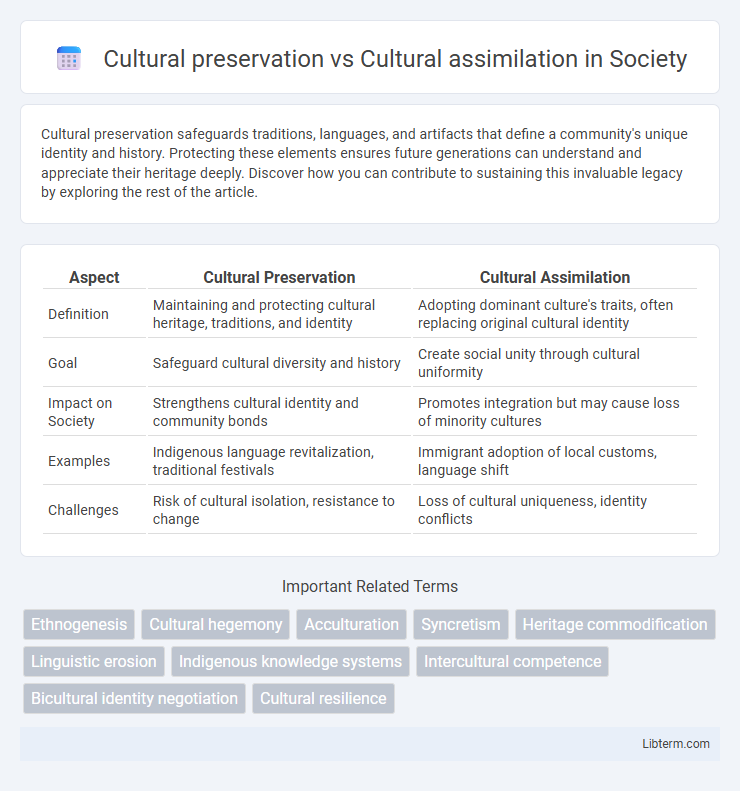Cultural preservation safeguards traditions, languages, and artifacts that define a community's unique identity and history. Protecting these elements ensures future generations can understand and appreciate their heritage deeply. Discover how you can contribute to sustaining this invaluable legacy by exploring the rest of the article.
Table of Comparison
| Aspect | Cultural Preservation | Cultural Assimilation |
|---|---|---|
| Definition | Maintaining and protecting cultural heritage, traditions, and identity | Adopting dominant culture's traits, often replacing original cultural identity |
| Goal | Safeguard cultural diversity and history | Create social unity through cultural uniformity |
| Impact on Society | Strengthens cultural identity and community bonds | Promotes integration but may cause loss of minority cultures |
| Examples | Indigenous language revitalization, traditional festivals | Immigrant adoption of local customs, language shift |
| Challenges | Risk of cultural isolation, resistance to change | Loss of cultural uniqueness, identity conflicts |
Understanding Cultural Preservation: Definition and Importance
Cultural preservation involves actively maintaining and protecting the customs, traditions, languages, and artifacts that define a community's heritage, ensuring that these elements are passed down to future generations. It plays a crucial role in fostering a strong sense of identity and community belonging, while promoting diversity and intercultural understanding in increasingly globalized societies. Protecting intangible cultural heritage, such as oral traditions and rituals, alongside tangible heritage like monuments and art, is essential to sustaining the richness of human history and preventing cultural homogenization.
The Concept of Cultural Assimilation: An Overview
Cultural assimilation refers to the process by which individuals or groups adopt the cultural traits or social patterns of another group, often resulting in the absorption and eventual loss of their original cultural identity. This phenomenon is frequently observed in contexts of migration, colonization, or globalization, where dominant cultures influence minority communities. The interplay between assimilation and cultural preservation shapes social dynamics and impacts the continuity of diverse cultural heritages worldwide.
Historical Contexts: Case Studies of Preservation and Assimilation
Historical contexts reveal that cultural preservation efforts, such as the revitalization of Native American languages in the United States, serve to maintain Indigenous identities despite centuries of forced assimilation policies. In contrast, the assimilation policies implemented in Australia's Stolen Generations exemplify how government-enforced cultural integration aimed to erase Aboriginal heritage. Case studies from these regions underscore the ongoing tension between preserving cultural heritage and the pressures of assimilation driven by colonial histories.
Factors Driving Cultural Assimilation in Modern Societies
Rapid globalization accelerates cultural assimilation by promoting dominant languages and media, influencing local customs and identities to align with global norms. Urbanization and migration introduce diverse populations into cosmopolitan areas, facilitating cultural blending and often diminishing distinct cultural practices. Technological advancements and mass communication further propagate mainstream cultural values, reducing the transmission of traditional heritage to younger generations.
Benefits and Challenges of Cultural Preservation
Cultural preservation fosters the safeguarding of unique traditions, languages, and customs, ensuring intergenerational transmission and community identity reinforcement. It strengthens social cohesion and promotes diversity within multicultural societies, contributing to global heritage and tourism. Challenges include resistance to change, potential isolation from broader societal integration, and the resource-intensive nature of maintaining cultural practices in modern contexts.
The Impact of Assimilation on Minority Cultures
Assimilation often leads to the erosion of minority cultures by diminishing distinct languages, traditions, and social norms that define their identity. The loss of cultural heritage can result in weakened community cohesion and reduced intergenerational knowledge transmission. Preservation efforts emphasize the protection of cultural diversity to maintain unique worldviews and historical continuity.
Balancing Integration and Identity: Finding Common Ground
Balancing integration and identity requires respecting diverse cultural heritages while fostering social cohesion within multicultural societies. Strategies such as inclusive education, community dialogue, and policy frameworks support cultural preservation alongside gradual assimilation, allowing individuals to maintain unique identities without social exclusion. Emphasizing shared values and mutual respect creates common ground for harmonious coexistence and sustainable diversity management.
Role of Education in Shaping Cultural Outcomes
Education plays a pivotal role in cultural preservation by incorporating indigenous languages, traditions, and histories into the curriculum, thereby strengthening cultural identity and continuity. Conversely, educational systems that prioritize dominant cultural norms often accelerate cultural assimilation, leading to the erosion of minority cultural practices and languages. Tailoring education to respect and promote cultural diversity can balance preservation and assimilation, fostering inclusive societies with enriched cultural landscapes.
Government Policies: Support for Preservation or Assimilation?
Government policies play a crucial role in influencing cultural preservation and assimilation, often reflecting a country's stance toward minority communities. Preservation-focused policies provide funding for language revitalization, cultural education programs, and protection of indigenous rights, promoting diversity and social cohesion. In contrast, assimilation policies emphasize integration through standardized education, national language promotion, and uniform legal frameworks, often prioritizing national unity over cultural distinctiveness.
Future Prospects: Navigating Cultural Change in a Globalized World
Future prospects for cultural preservation and assimilation revolve around balancing global interconnectedness with safeguarding unique identities. Technologies facilitating documentation and sharing of cultural practices enable communities to maintain heritage while engaging with global audiences. Educational initiatives and policy frameworks promoting intercultural dialogue support adaptive cultural resilience amid rapid globalization.
Cultural preservation Infographic

 libterm.com
libterm.com